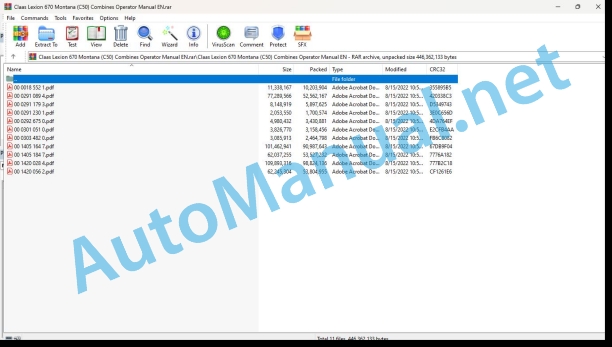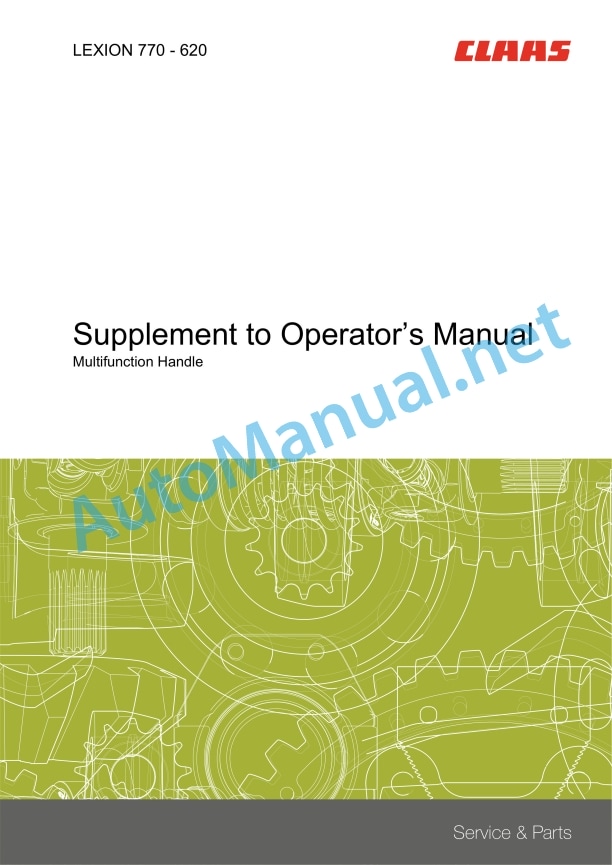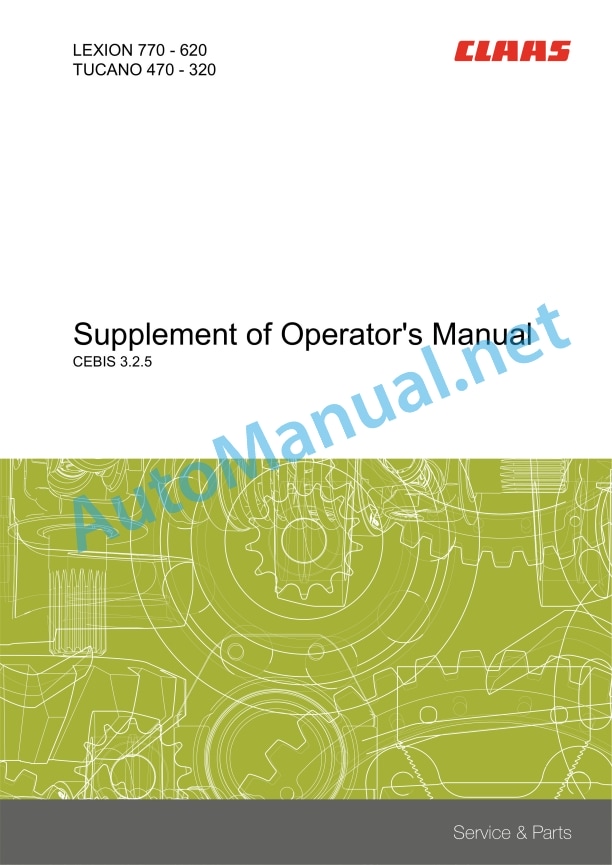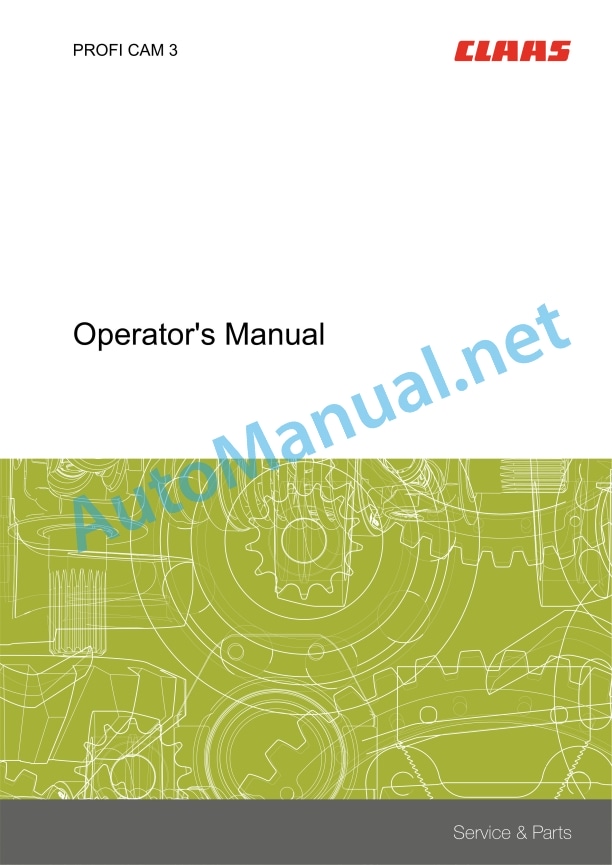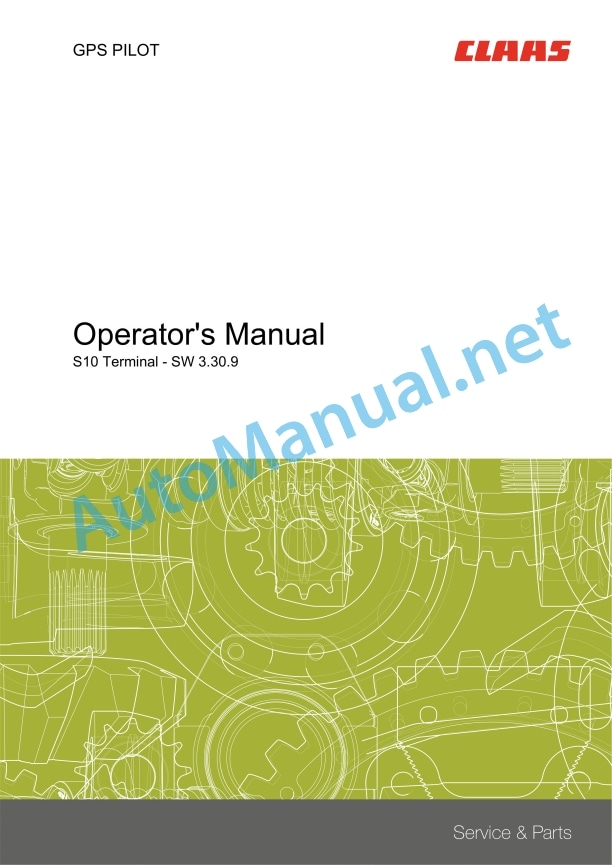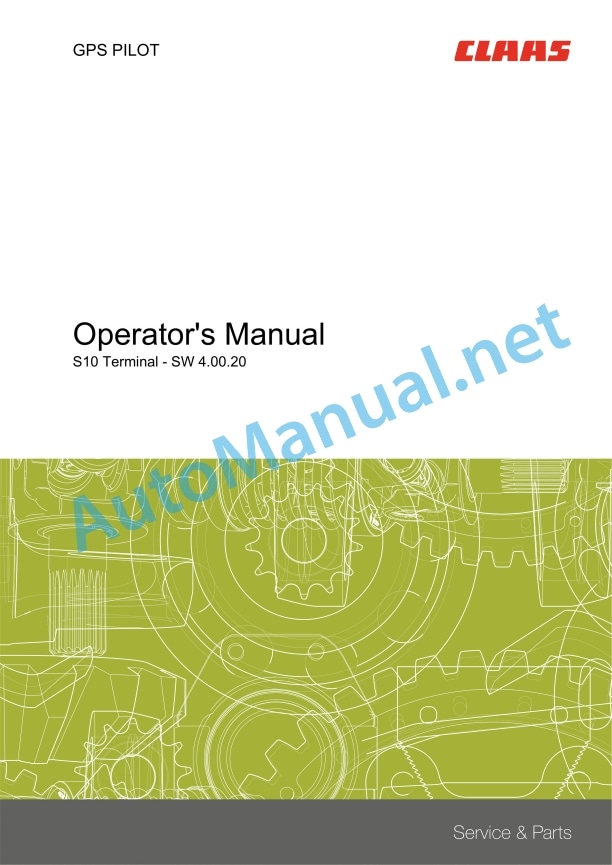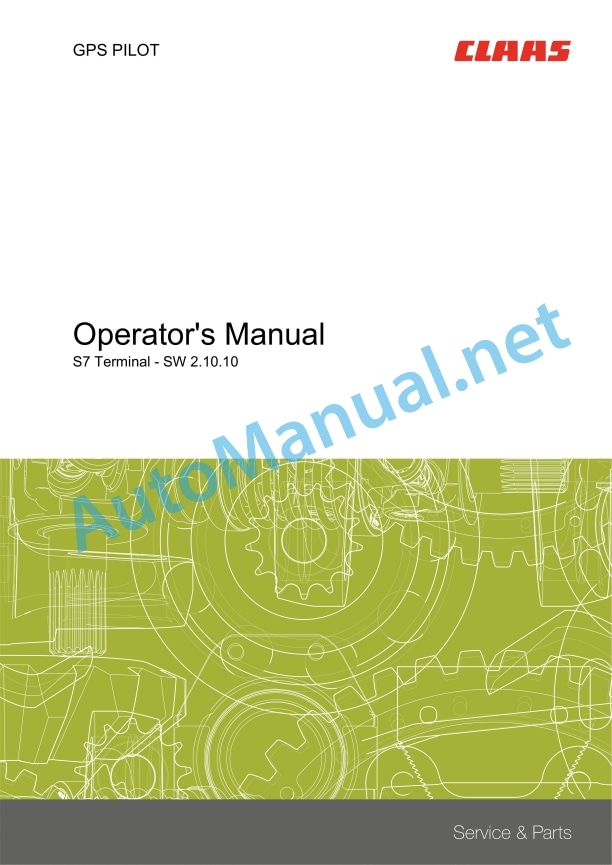Claas Lexion 670 Montana (C50) Combines Operator Manual EN
$50.00
- Model: Lexion 670 Montana (C50) Combines
- Type Of Manual: Operator Manual
- Language: EN
- Format: PDF(s)
- Size: 359 MB
File List:
00 0018 552 1.pdf
00 0291 089 4.pdf
00 0291 179 3.pdf
00 0291 230 1.pdf
00 0292 675 0.pdf
00 0301 051 0.pdf
00 0303 482 0.pdf
00 1405 164 7.pdf
00 1405 184 7.pdf
00 1420 028 4.pdf
00 1420 056 2.pdf
00 0018 552 1.pdf:
TELEMATICS Website
Table of contents
1 About this Concise Operator’s Manual
1.1 Notes on the manual
1.1.1 Validity of manual
1.1.2 Notes regarding the Concise Operator’s Manual
1.1.3 Notes on warranty
2 Safety
2.1 Intended use
2.1.1 Proper use
3 Product description
3.1 Overview and method of operation
3.1.1 TELEMATICS product variants
3.1.2 TONI (TELEMATICS on implements)
3.1.3 Fleet View
3.1.4 TELEMATICS basic
3.1.5 TELEMATICS advanced
3.1.6 TELEMATICS professional
3.1.7 TELEMATICS app
4 Operating and control elements
4.1 TELEMATICS overview
4.1.1 Illustration conventions of buttons and navigation elements
4.1.2 Symbols and colours
4.2 Menu structure
4.2.1 Start screen
4.2.2 TELEMATICS website site map
4.2.3 Main menu overview
4.2.4
4.2.5
4.2.6
00 0291 179 3.pdf:
LEXION 750 MONTANA
LEXION 670 MONTANA
LEXION 630 MONTANA
Table of contents
1 Introduction
1.1 General Information
1.1.1 Validity of manual
2 Safety
2.1 General Information
2.1.1 Operation with slope compensation
2.2 Safety decals
2.2.1 Cab / Operator’s platform
2.2.2 Feeder unit
3 Technical specifications
3.1 LEXION 750 / 670 / 630 MONTANA – Type C51 / C50 / C52
3.1.1 Machine equipment for technical specifications
3.1.2 Chassis
3.1.3 Chassis tyre pressure
3.1.4 Chassis wheel tread
3.1.5 Brake
3.1.6 Grain delivery dimensions
3.1.7 Dimensions of attachment parts / machine body
4 Before putting into initial operation
4.1 General Information
4.1.1 General warnings
4.1.2 Initial commissioning check list
4.2 Chassis
4.2.1 Removing / installing the wheels
4.2.2 Overview of rear axle
4.2.3 Jacking up the machine for rear axle pendulum movements
4.2.4 Converting the rear drive axle from transport position to working position
4.2.5 Rear drive axle 00 0694 642 X – Adjusting the wheel tread
4.2.6 Converting the rear axle 00 0775 540 X from transport to working position
4.2.7 Rear axle 00 0775 540 X – Adjusting the wheel tread
4.2.8 Converting the rear axle 00 0769 105 X from transport to working position
4.3 Hydraulic system
4.3.1 Checking / filling the front attachment load relief accumulator
4.4 Various components / Machine body
4.4.1 Access to LEXION 670 MONTANA
4.4.2 Access for LEXION 750 / 630 MONTANA
4.4.3 Pre-assembling the access ladder (LEXION 750 / 670 / 630 MONTANA)
4.4.4 Installing the access ladder (LEXION 750 / 670 / 630 MONTANA)
4.4.5 Fitting the additional weights for folding front attachments
5 Before every operation
5.1 General Information
5.1.1 General warnings
5.1.2 Putting into operation check list
6 Fitting / removing the front attachment
6.1 General Information
6.1.1 General warnings Fitting / removing the front attachment
6.2 Hydraulic system
6.2.1 Mounting the multi-coupler
6.2.2 Dismounting the multi-coupler
7 Controls Overview
7.1 General Information
7.1.1 General warnings Controls overview
7.2 Cab / Operator’s platform
7.2.1 Overview of operator’s platform
7.2.2 Control panel
7.2.3 MONTANA control system control panel
8 Driving and transportation
8.1 General Information
8.1.1 General warnings Driving and transportation
8.2 Gearbox / Clutch / Universal drive shaft
8.2.1 Differential lock
8.3 Chassis
8.3.1 Shifting gears
8.3.2 MONTANA control system
8.3.3 Checking the MONTANA functions
8.3.4 Switching on the MONTANA control system
8.3.5 Lowering the machine fully before driving on the road
8.3.6 Moving the machine into the neutral position
8.3.7 Manual axle control
8.3.8 Manual front attachment control
8.3.9 Automatic mode
8.3.10 Changing the cutting angle/tilt (lateral levelling) in automatic mode
8.4 Brake
8.4.1 Applying the parking brake
8.4.2 Releasing the parking brake
8.5 Various components / Machine body
8.5.1 Folding the ladder steps
8.5.2 Rotating the access ladder
9 Fieldwork settings
9.1 General Information
9.1.1 General warnings for fieldwork settings
9.2 Feed rake
9.2.1 Adjusting the feeder chain height
9.3 Threshing mechanism
9.3.1 Drum inspection cover
10 Faults and remedies
10.1 General Information
10.1.1 General warnings – Problems and remedies
10.2 Gearbox / Clutch / Universal drive shaft
10.2.1 Mechanically placing the gearbox in neutral
10.3 Brake
10.3.1 Releasing the parking brake mechanically
10.4 Chassis
10.4.1 Chassis problems and remedies
10.5 Electrical / Electronic equipment
10.5.1 MONTANA control system problems and remedies
10.6 Feeder unit
10.6.1 Problems with and remedies for the feeder unit
11 Maintenance
11.1 General Information
11.1.1 General maintenance warnings
11.2 Maintenance schedules
11.2.1 Maintenance intervals
11.3 Lubricants charts
11.3.1 Lubricants
11.4 Lubrication chart
11.4.1 Lubrication points – 100 h left
11.4.2 Lubrication points – 100 h right
11.4.3 Lubrication points – 500 h left
11.4.4 Lubrication points – 500 h right
11.5 Chassis
11.5.1 Checking the differential and axle carrier oil level
11.5.2 Draining the differential and axle carrier oil
11.5.3 Adding differential and axle carrier oil
11.5.4 Checking the swing arm oil level
11.5.5 Draining the swing arm oil
11.5.6 Adding swing arm oil
11.5.7 Lubrication instructions for swing arm slewing rings
11.5.8 Basic adjustment of swing arm linkage
11.5.9 Checking the drive axle manual gearbox oil level
11.5.10 Draining the drive axle manual gearbox oil
11.5.11 Topping up the drive axle manual gearbox oil
11.5.12 Checking the final drive oil level
11.5.13 Draining the final drive oil
11.5.14 Adding the final drive oil
11.6 Feeder unit
11.6.1 MONTANA feed rake conveyor – adjusting the feeder chains
11.6.2 Basic adjustment of linkage for the cutting angle
11.6.3 Basic adjustment of lateral levelling linkage
11.6.4 Basic adjustment of lateral position linkage
00 0291 230 1.pdf:
LEXION 770 – 620
Table of contents
1 Introduction
1.1 General Information
1.1.1 Validity of manual
2 Controls Overview
2.1 Cab / Operator’s platform
2.1.1 Multifunction handle
00 0292 675 0.pdf:
LEXION 770 – 620TUCANO 470 – 320
Table of contents
1 To this operator’s manual
1.1 General Information
1.1.1 Validity of manual
1.1.2 Symbols and notes
2 Operating and control elements
2.1 Cab / Operator’s platform
2.1.1 CEBIS control panel
2.2 Board computer CEBIS
2.2.1 General instructions – CEBIS
2.2.2 Vehicle control display overview
2.2.3 Vehicle control display overview
2.2.4 Harvest display overview
2.2.5 CRUISE PILOT harvest display overview
2.2.6 CEBIS direct menu overview
2.2.7 Understanding CEBIS fault code information
Understanding the type of fault code information
Understanding the format of fault code information
Clearing fault code information
Viewing the alarm history
Viewing active alarms
2.2.8 Symbols in windows
2.2.9 CEBIS direct menu
2.2.10 HOTKEY direct menu
2.2.11 Quick access menu
2.2.12 Main menu
2.2.13 Front attachment menu
2.2.14 Driving menu
2.2.15 AUTO PILOT menu
2.2.16 Machine settings menu
2.2.17 Crop settings menu
2.2.18 Recorder menu
2.2.19 Maintenance menu
2.2.20 CEBIS menu
00 0301 051 0.pdf:
PROFI CAM 3
Table of contents
1 Introduction
1.1 Notes on the manual
1.1.1 Validity of manual
1.1.2 Information about this Operator’s Manual
1.1.3 Symbols and notes
1.1.4 Optional equipment
1.1.5 Qualified specialist workshop
1.1.6 Maintenance information
1.1.7 Warranty notes
1.1.8 Spare parts and technical questions
1.2 Intended use
1.2.1 Intended use
1.2.2 Reasonably foreseeable misuse
2 Safety
2.1 Identifying warnings
2.1.1 Hazard signs
2.1.2 Signal word
2.2 Safety rules
2.2.1 Meaning of Operator’s Manual
2.2.2 Observing safety decals and warnings
2.2.3 Optional equipment and spare parts
3 Product description
3.1 Overview and method of operation
3.1.1 How the PROFI CAM works
3.2 Identification plates and identification number
3.2.1 Position of identification plates
3.2.2 Explanation of PROFI CAM identification plate
3.3 Information on the product
3.3.1 CE marking
4 Operating and control elements
4.1 Camera system
4.1.1 Camera system monitor
4.2 Menu structure
4.2.1 Main menu
4.2.2
4.2.3
4.2.4
4.2.5
4.2.6
5 Technical specifications
5.1 PROFI CAM
5.1.1 Monitor
5.1.2 Camera
5.1.3 Switch box
5.1.4 Degree of protection against foreign bodies and water
6 Preparing the product
6.1 Shutting down and securing the machine
6.1.1 Switching off and securing the machine
6.2 Prior to operation
6.2.1 Carry out prior to operation
6.2.2 Installing the sun protection
6.2.3 Aligning the camera
6.2.4 Connecting the camera electrics
7 Operation
7.1 Monitor
7.1.1 Switching on the monitor
7.1.2 Calling up the menu
7.1.3 Setting a menu item
7.1.4 Setting the image orientation
7.1.5 Setting automatic screen darkening
7.1.6 Image mirroring
7.1.7 Setting the trigger view
7.1.8 Setting the follow-up time for trigger view
7.1.9 Setting the display mode
7.1.10 Activating/deactivating a display mode
8 Faults and remedies
8.1 Electrical and electronic system
8.1.1 Overview of problems on PROFI CAM camera system
8.1.2 Replacing the switch box fuse
9 Maintenance
9.1 Maintenance intervals
9.1.1 Every 10 operating hours or daily
9.2 Camera system
9.2.1 Checking the camera system for dirt
9.2.2 Cleaning the camera
9.2.3 Cleaning the switch box
9.2.4 Cleaning the monitor
10 Placing out of operation and disposal
10.1 General Information
10.1.1 Putting out of operation and disposal
11 Technical terms and abbreviations
11.1 Abbreviations
11.1.1 Units
11.1.2 Abbreviations
11.1.3 Technical terms
00 0303 482 0.pdf:
PROFI CAM 4
Table of contents
1 Introduction
1.1 Notes on the manual
1.1.1 Validity of manual
1.1.2 Information about this Operator’s Manual
1.1.3 Symbols and notes
1.1.4 Optional equipment
1.1.5 Qualified specialist workshop
1.1.6 Maintenance information
1.1.7 Notes on warranty
1.1.8 Spare parts and technical questions
1.2 Intended use
1.2.1 Intended use
1.2.2 Reasonably foreseeable misuse
2 Safety
2.1 Identifying warnings
2.1.1 Hazard signs
2.1.2 Signal word
2.2 Safety rules
2.2.1 Meaning of Operator’s Manual
2.2.2 Structural changes
2.2.3 Optional equipment and spare parts
2.2.4 Operation only following proper putting into operation
2.2.5 Technical status
2.2.6 Respecting technical limit values
Respecting technical limit values
2.2.7 Hazards when driving on roads and fields
3 Product description
3.1 Overview and method of operation
3.1.1 How the PROFI CAM works
3.2 Identification plates and identification number
3.2.1 Identification plates
3.3 Information on the product
3.3.1 CE marking
4 Operating and display elements
4.1 Camera system
4.1.1 Camera system monitor
4.1.2 CEBIS
4.2 Menu structure
4.2.1 Main menu
4.2.2
4.2.3
4.2.4
4.2.5
4.2.6
5 Technical specifications
5.1 PROFI CAM
5.1.1 Monitor
5.1.2 Camera
5.1.3 Switch box
6 Preparing the product
6.1 Switching off and securing the machine
6.1.1 Switching off and securing the machine
6.2 Prior to putting into operation
6.2.1 Carry out prior to operation
6.2.2 Installing the sun protection
6.2.3 Aligning the camera
7 Operation
7.1 Monitor
7.1.1 Switching on the monitor
7.1.2 Calling up the menu
7.1.3 Setting a menu item
7.1.4 Setting the image orientation
7.1.5 Setting automatic screen darkening
7.1.6 Image mirroring
7.1.7 Setting the trigger view
7.1.8 Setting the follow-up time for trigger view
7.1.9 Setting the display mode
7.1.10 Activating/deactivating a display mode
8 Faults and remedies
8.1 Electric and electronic system
8.1.1 Overview of problems on PROFI CAM camera system
9 Maintenance
9.1 Maintenance intervals
9.1.1 Every 10 operating hours or daily
9.2 Camera system
9.2.1 Checking the camera system for dirt
9.2.2 Cleaning the camera
9.2.3 Cleaning the switch box
9.2.4 Cleaning the monitor
10 Putting out of operation and disposal
10.1 General information
10.1.1 Putting out of operation and disposal
11 Technical terms and abbreviations
11.1 Abbreviations
11.1.1 Units
11.1.2 Abbreviations
11.1.3 Technical terms
00 1405 164 7.pdf:
GPS PILOT
Table of contents
1 Introduction
1.1 General information
1.1.1 Validity of Manual
1.1.2 Information about this Operator’s Manual
1.1.3 Symbols and notes
1.1.4 Optional equipment
1.1.5 Qualified specialist workshop
1.1.6 Maintenance notes
1.1.7 Notes on warranty
1.1.8 Spare parts and technical questions
1.1.9 Licensing for road traffic
Sample report
Clearance certificate
General operating permit
1.2 Intended use
1.2.1 Intended use
1.2.2 Reasonably foreseeable misuse
2 Safety
2.1 Identifying warnings
2.1.1 Hazard signs
2.1.2 Signal word
2.2 Safety rules
2.2.1 Meaning of Operator’s Manual
2.2.2 Update of terminal software
2.2.3 Requirements made on all persons working with the product
2.2.4 Hazard areas
Hazard areas
2.2.5 Interaction between the control terminal and the machine or tractor
2.2.6 Structural changes
2.2.7 Optional equipment and spare parts
2.2.8 Use of USB devices
2.2.9 Operation only following proper putting into operation
2.2.10 Technical status
2.2.11 Hazard from damage on the product
2.2.12 Respecting technical limit values
Respecting technical limit values
2.2.13 Preparing the product for road travel
2.2.14 Hazards when driving on the road with an ISOBUS implement
Switching on the terminal during road travel.
2.2.15 Hazards when driving on the road and on the field
2.2.16 Electrocution by electrical system
2.2.17 Potentially fatal electric shock from overhead lines
2.2.18 Liquids under pressure
2.2.19 Maintenance operations and repair work
2.2.20 Driving with the GPS PILOT
Road travel
Fieldwork
2.2.21 Working with Task Control* and Section Control*
3 Product description
3.1 Overview and method of operation
3.1.1 Overview of GPS PILOT – Hydraulic system
3.1.2 Overview of GPS PILOT – Steer ready
3.1.3 Overview of GPS PILOT FLEX
3.1.4 Overview of GPS PILOT ex works
3.1.5 Overview of the S10 terminal
3.1.6 Overview of navigation computer (ECU)
3.1.7 Electric steering wheel
3.1.8 Overview of correction signals
EGNOS/WAAS/MSAS
Omnistar HP / XP / G2
RTK FIELD BASE and BASELINE HD
RTK FARM BASE
3.1.9 Module overview
BASELINE HD
RTK FIELD BASE
RTK (Motorola)
RTK FARM BASE
3.2 Safety devices
3.2.1 Automatic cut-out when the maximum speed is exceeded
3.2.2 Automatic cut-out when the speed falls below the minimum
3.2.3 Seat contact switch
3.2.4 Manual override
Electric steering wheel
3.3 Optional equipment
3.3.1 GPS L2*
3.3.2 GLONASS*
3.3.3 TURN IN*
3.3.4 AUTO TURN*
3.3.5 Task Control*
Task Control Basic*
Task Control Geo*
3.3.6 Section Control*
3.4 Identification plates and identification numbers
3.4.1 GPS PILOT identification plate
3.4.2 Identification plate of terminal
3.4.3 Identification plate of navigation controller
4 Operating and display elements
4.1 GPS PILOT
4.1.1 Master switch and drive switch
4.2 Overview of the S10 terminal
4.2.1 Layout conventions of buttons and displays
4.3 GPS PILOT menu structure
4.3.1 Start menu
Start menu without Task Control*
Start menu with Task Control*
4.3.2 Menu overview
4.3.3 Overview of display field
4.3.4
4.3.5
4.3.6
John Deere Repair Technical Manual PDF
John Deere POWERTECH E 4.5 and 6.8 L Diesel Engines TECHNICAL MANUAL 25JAN08
John Deere Repair Technical Manual PDF
John Deere Transmission Control Unit Component Technical Manual CTM157 15JUL05
John Deere Repair Technical Manual PDF
John Deere Repair Technical Manual PDF
John Deere Repair Technical Manual PDF
John Deere Repair Technical Manual PDF
John Deere Repair Technical Manual PDF
John Deere Repair Technical Manual PDF
New Holland Service Manual PDF

